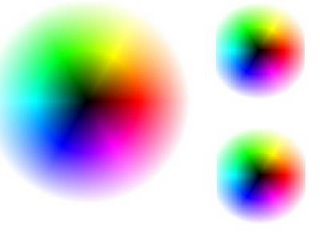
Focus Your eye on the
epicentre of any of the circle.
See what happens !
Is it the colours melt down ? ! ! !
So is Chakravaham. When you sing Chakravaham, empathy
fills your soul in a way that you forget your own sorrows.
CHAKRAVAHAM
In an earlier posting we discussed that while Kamal sings of Sreevidya
as
"indira logathu chakravaham
(Adhisaya raagam in Aboorva Ragangal)
the raga portrayed there is not Chakravaham but valaji.
Chakravaham would have, nervertheless, not suited the particular
occasion of the song. We will know why, when we understand the
qualities of the raga and what it symbolises.
Chakravaham, known by the name Ahir Bhairav in HCM, belongs to the
Bhairva thaat and is suited for pre dawn riyaaz.
Arokan: S r G m P D n S
Avr. : S n D P m G r S
Upto P it follows the route of Mayamalav Gowla whereafter it takes on
Karaharapriya. This combination the surs provides the raga with an
innate energy and also epitomizes the melody.
Listen to the song
"Mera bina tum bhi na roye" (Dekh Karbhira roya).
Follow it up with the second line of the pallavi
"Sajana, Sajana ,
Sajna"
where Lata does the sancharam on almost the entire sur track of
the raga. It at once brings forth the pangs of the singer, her heart
throbbing with longing, a sense of helplessness, a vague feeling of
self pity and what not!
A recent "Albela Sajan Aayore" in Hum Dil Dechhuke Sanam utilises the
raga very beautifully. The various alaaps and chitaswaras cropping up
throughout the song, very naturally and yet so forcefully, are a feast
to both the ears and mind of an enlightened listener.
That the raga can metamorphosise a very mundane and medicocre sequence
is very well demonstrated in the title song of Ram teri Ganga maili ho
gayee. If there was something worthwhile in the movie (which was
otherwise an act of exhibitionism or voyeristic on the part of the
viewer) it was the saving grace of Ravindra Jain's music, particulary
the title song.
The seperation of love is again brought out very beautifully in "Sola
Baras ki bali umar ko salaam" in Ek Duje ke liye, the film that
propelled Kamal Hasan to a shortlived superstardom in Hindi filmdom.The
contribution of LP's music to the stupundous sucess of the movie cannot
be undermined.
Down south in Tamil films, a methodic song from a lesser known film
"Sandhega kodu athu sandhoshak kedu" and "vidukathaya" from Muthu
(A.R.Rahman) pertain to this raga. A lighter song
"Nee padhi nann padhi
kanne" is another example
The epitome, however, is to be seen in the immortal mythological film,
Karnan, music by the duo Vis and Ram.
Visualise the epic climatic scene in the movie, the thespian, Shivaji
Ganesan, panting for breath pierced with arrows all over the body, with
only Dharam protecting him and NTR (Krsna) assuming the role of a
brahmin to beg for even that Dharam. NTR leaves the usual mischievous
skin akin to the character of the Lord and dons on a mystified empathy
which flows through his eyes. He is guilty he has to make way for the
death of the Great Soul but it is in the overall scheme of things and
has to happen and is helpless, despite being Lord.
The empathy woven
throughout the lyric and music is unforgettable for ages.
The final charanam which goes
"Mannavar Pani serka Kannanum Pani Seidu
Unnadi panivanada, avanai Mannithu arul seyyada"
is very memorable for
the content and expression. Play the particular charanam on an
instrument or sing it over, you would realise immediately the qualities
springing from a mere short alaap of this divine raga.
Empathy is the
other name of Chakaravaham.
No comments:
Post a Comment